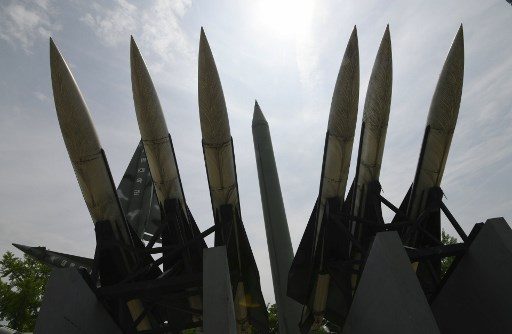SUMMARY
This is AI generated summarization, which may have errors. For context, always refer to the full article.

SEOUL, South Korea (3rd UPDATE) – North Korea welcomed a US envoy’s visit to Seoul by firing two missiles Thursday, May 9, the South’s military said, in Pyongyang’s second launch in less than a week as it seeks to up the ante in deadlocked nuclear negotiations with Washington.
It came after North Korea carried out a military drill and fired multiple projectiles on Saturday, May 4, with at least one believed to be a short-range missile.
The North had not previously fired a missile since November 2017, shortly before a rapid diplomatic thaw eased high tensions on the peninsula and paved the way for a historic first meeting between its leader Kim Jong-un and US President Donald Trump.
But their second summit in Vietnam in February broke up without an agreement rolling back Pyongyang’s nuclear program in exchange for sanctions relief or even a joint statement, leaving the North frustrated.
Thursday’s launch came hours after the US Special Representative on North Korea, Stephen Biegun, arrived in Seoul late Wednesday, May 8, for talks with South Korean officials, in his first visit since the Hanoi summit.
South Korean President Moon Jae-in said Pyongyang’s latest move had “an element of protest and is a pressuring action to steer the nuclear talks in a direction it desires.”
“It appears the North is highly displeased that the Hanoi summit ended without agreement,” he said in an interview marking his first two years in office.
But he added: “Whatever North Korea’s intentions might have been, we warn that it could make negotiations more difficult.”
The North “fired what appeared to be two short-range missiles” from Kusong in North Pyongan province, Seoul’s Joint Chiefs of Staff (JCS) said in a statement, updating its earlier assessment that the launch was from Sino-ri in the same province.
The JCS added the missiles flew eastwards for 270 and 420 kilometers (170 and 260 miles) and the South Korean and US militaries were jointly analyzing them.
Biegun met his South Korean counterpart Lee Do-hoon for breakfast on Thursday and is due to hold discussions with the South’s foreign and unification ministers Friday, May 10, as the security allies – Washington stations 28,500 troops in the South to defend it from its neighbor – work on their approach towards Pyongyang.
With Thursday’s launch, said Hong Min, a senior researcher at the state-run Korea Institute for National Unification, “North Korea is sending a clear message that it will not be satisfied with humanitarian aid” being considered by Seoul.
“It is saying, ‘We want security guarantees in return for the denuclearization process’,” he added.
“Kim could have felt he needed to show a strong military posture…following a joint South-US military drill last month.”
Harry Kazianis of the Center for the National Interest added that the North had “once again chosen a course of action today that can only worsen already growing tensions.
“Kim’s goal, beyond ensuring his weapons programs are becoming more powerful, is quite clear: to show America and its allies that if they aren’t willing to compromise on the terms of denuclearization that Pyongyang will indeed go its own way.”
‘Flying objects’
Pyongyang, Seoul and Washington had all refrained from explicitly calling Saturday’s launch a missile – the South used the term “projectile” – which could jeopardize the ongoing diplomacy if it violated UN Security Council resolutions against ballistic technology as well as Kim’s announcement of an end to long-range missile tests.
If Thursday’s launch proved to be a ballistic missile, Moon said, even if it was short-range, “it has a possibility of running foul of UN resolutions.”
Experts said at least one short-range ballistic missile was involved on Saturday, with a report on the respected 38 North website suggesting that it was a “direct import” of a Russian-produced Iskander.
“The debris generated by the launch in North Korea is a virtual match of a launch of Iskander conducted by Russia,” it said.
If North Korea had imported Iskanders from Russia, the report added, “it has an existing capacity to deliver warheads to targets in South Korea with great precision.”
Pyongyang insisted earlier Thursday that Saturday’s “routine drill” was conducted within its own waters and added the “flying objects” did not pose any threat to the US, South Korea and Japan.
“The firing of the intermediate- and long-range missile and the ICBM was not involved in it,” a spokesman for the North’s delegation for military talks with the South said in a statement carried by the official Korean Central News Agency, condemning Seoul’s criticism.
A summit between Moon and Kim a year ago was instrumental in lowering the temperature, but since the Hanoi summit the North has blamed Seoul for siding with Washington, leaving inter-Korean relations in limbo. – Rappler.com
Add a comment
How does this make you feel?
There are no comments yet. Add your comment to start the conversation.